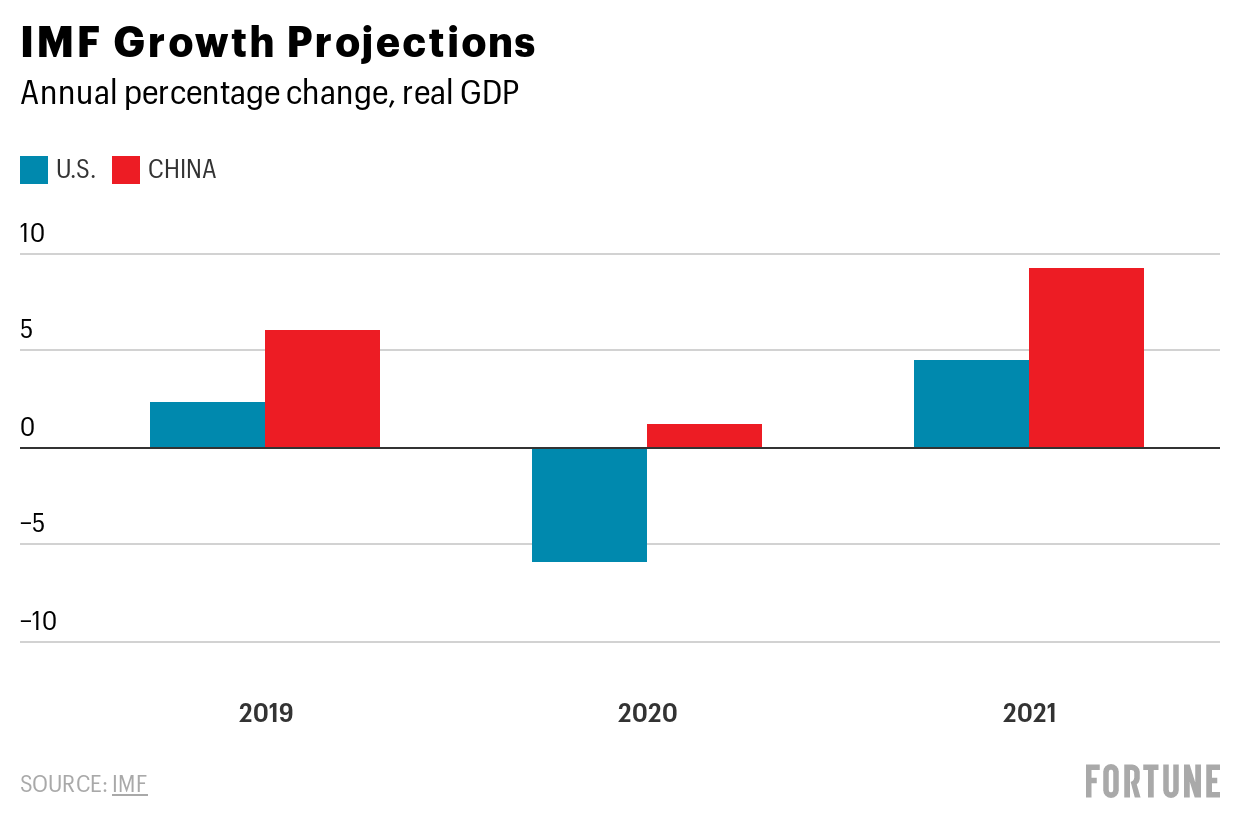正如上周相继公布的两项严峻的统计数据所示,新冠病毒已经让世界上最大的两个经济体停摆。
4月16日,美国劳工部报告称,过去四周,失业救济申请人数超过2,200万,比美国经济在过去九年创造的所有就业岗位还要多。4月17日,中国国家统计局宣布,中国1月至3月之间GDP下降了6.8%,创下数十年来的季度跌幅纪录。
然而,就像一些病毒感染者比其他患者康复得更快一样,中美两国经济很可能以不同的速度复苏。这场危机爆发前,美国经济稳步增长,消费者信心高涨,失业率接近历史低点,可谓风头正劲。中国经济则呈现趋缓迹象。特朗普总统信誓旦旦地承诺称,一旦新冠疫情得到遏制,美国经济将“像火箭起飞一样”迅速增长。
但是,许多经济学家则预测,美国经济将在今年剩余时间里放缓,甚至负增长,而中国经济则有望在下半年反弹。
“我觉得,美国的处境显然更艰难,因为它应对疫情的时间点晚于中国,封锁措施也不像中国那样全面。”北京佳富龙洲咨询公司的经济学家葛艺豪说。
供职于私营部门的经济学家中,越来越多的人认为中国经济将在本季度出现转机,这并不是说他们认为中国经济会迎来V型反转,即经济增长会像它突然消失一样迅速反弹。但的确,一些经济学家预计,中国经济将在今年的最后三个月逐渐恢复到危机前接近6%的增长率。
中国3月的数据显示,与1月和2月相比,零售额、用电量和固定资产投资的下滑速度有所放缓,汽车销量则大幅上扬。马修亚洲基金管理公司的投资策略师罗福万据此认为,这表明中国已经“走上复苏之路”。
中国经济峰回路转的另一个迹象是:法国奢侈品巨头路威酩轩集团表示,中国内地路易·威登门店在过去三周的销售额跟去年同期相比增长了50%。欧莱雅的首席执行官安巩在4月16日透露称,该公司3月的在华销售额转为正,本月可能会增长5%至10%。
4月15日,国际货币基金组织发布报告,预计2020年中国国内生产总值较上一年增长1.2%,还将在2021年飙涨9.2%。该组织预计,2020年美国经济将萎缩5.9%,然后在2021年增长4.7%。罗福万认为,IMF对两大经济体增长前景的预测“都过高了,但总体来说,我是认同这种趋势的。”

这场大疫情已经导致两国都有数百万人失业,但美国的失业人数看起来要高得多。中国的城镇调查失业率多年保持在5%左右,根据中国国家统计局最近发布的数据,这个数字在2月升至6.2%,已经算是创纪录了。(值得注意的是,这些数据并没有反映数百万农民工的困境:春节期间,由于全国各地采取隔离措施,再加上工厂停工,大批返乡过年的农民工无法重返工作岗位。)高盛集团预计,美国今年的失业率将超过15%,而2019年年底的失业率仅为3.5%。国会预算办公室则认为,美国失业率在2021年年底之前,都将保持在9%上下。
中国比美国更容易重启经济的一个原因是,制造业工人在中国劳动人口中的占比远高于美国。制造业约占中国GDP的40%,而美国的这一比例仅为11%左右。“推动工厂复工复产,远比让消费者重拾外出消费的习惯容易得多。”葛艺豪说。
对于中美两国领导人来说,经济何时复苏,如何复苏,都可能带来挑战。中国政府为2020年确定的官方增长目标为6%。但新冠疫情使得实现这一目标有一定难度。
而特朗普面临的风险是,在11月大选投票日到来之际,美国将陷入衰退泥沼,与率先爆发疫情、经济形势却明显好转的中国形成鲜明对比。
虽然中国的病毒传播比美国早得多,但其对武汉及周边地区6,000万人口实施的严格隔离措施,成功使新增感染病例曲线趋于平缓。在武汉严格执行的封锁举措,从1月23日持续到了4月8日,但中国大部分地区的出行限制,早在2月中旬就已经放松。罗福万在一份写给客户的报告中指出:“从3月的下半月开始,中国大部分地区的生活逐渐恢复常态。”
到4月中旬,中国每日新增感染病例的15天平均值已经从2月中旬疫情高峰期的近4,000例降至50例左右。在美国,截至4月15日的15天平均值出现放缓迹象,但仍然超过3万例。到了4月19日,中国累计报告确诊病例约8.4万例,累计死亡病例4,700例,美国的累计确诊病例约73.5万例,死亡3.9万人。
08年全球金融危机爆发后,中国政府为提振经济而采取了4万亿人民币的大规模刺激措施,但到目前为止,中国似乎无意重复这样的举措。根据彭博经济研究的数据,中国为应对新冠疫情而宣布的财政刺激规模仅占其GDP的3%左右,而美国和日本的这一比例分别高达10%和20%。中国因此前的大量支出存在债务风险,整体债务规模已超过GDP的300%。
但罗福万认为,即使没有这种大规模刺激计划,中国依然是“世界上最好的消费市场”,他说,对于跨国公司和全球投资者来说,中国很可能仍然是一个极富吸引力的投资目的地。(财富中文网)
译者:任文科
正如上周相继公布的两项严峻的统计数据所示,新冠病毒已经让世界上最大的两个经济体停摆。
4月16日,美国劳工部报告称,过去四周,失业救济申请人数超过2,200万,比美国经济在过去九年创造的所有就业岗位还要多。4月17日,中国国家统计局宣布,中国1月至3月之间GDP下降了6.8%,创下数十年来的季度跌幅纪录。
然而,就像一些病毒感染者比其他患者康复得更快一样,中美两国经济很可能以不同的速度复苏。这场危机爆发前,美国经济稳步增长,消费者信心高涨,失业率接近历史低点,可谓风头正劲。中国经济则呈现趋缓迹象。特朗普总统信誓旦旦地承诺称,一旦新冠疫情得到遏制,美国经济将“像火箭起飞一样”迅速增长。
但是,许多经济学家则预测,美国经济将在今年剩余时间里放缓,甚至负增长,而中国经济则有望在下半年反弹。
“我觉得,美国的处境显然更艰难,因为它应对疫情的时间点晚于中国,封锁措施也不像中国那样全面。”北京佳富龙洲咨询公司的经济学家葛艺豪说。
供职于私营部门的经济学家中,越来越多的人认为中国经济将在本季度出现转机,这并不是说他们认为中国经济会迎来V型反转,即经济增长会像它突然消失一样迅速反弹。但的确,一些经济学家预计,中国经济将在今年的最后三个月逐渐恢复到危机前接近6%的增长率。
中国3月的数据显示,与1月和2月相比,零售额、用电量和固定资产投资的下滑速度有所放缓,汽车销量则大幅上扬。马修亚洲基金管理公司的投资策略师罗福万据此认为,这表明中国已经“走上复苏之路”。
中国经济峰回路转的另一个迹象是:法国奢侈品巨头路威酩轩集团表示,中国内地路易·威登门店在过去三周的销售额跟去年同期相比增长了50%。欧莱雅的首席执行官安巩在4月16日透露称,该公司3月的在华销售额转为正,本月可能会增长5%至10%。
4月15日,国际货币基金组织发布报告,预计2020年中国国内生产总值较上一年增长1.2%,还将在2021年飙涨9.2%。该组织预计,2020年美国经济将萎缩5.9%,然后在2021年增长4.7%。罗福万认为,IMF对两大经济体增长前景的预测“都过高了,但总体来说,我是认同这种趋势的。”
这场大疫情已经导致两国都有数百万人失业,但美国的失业人数看起来要高得多。中国的城镇调查失业率多年保持在5%左右,根据中国国家统计局最近发布的数据,这个数字在2月升至6.2%,已经算是创纪录了。(值得注意的是,这些数据并没有反映数百万农民工的困境:春节期间,由于全国各地采取隔离措施,再加上工厂停工,大批返乡过年的农民工无法重返工作岗位。)高盛集团预计,美国今年的失业率将超过15%,而2019年年底的失业率仅为3.5%。国会预算办公室则认为,美国失业率在2021年年底之前,都将保持在9%上下。
中国比美国更容易重启经济的一个原因是,制造业工人在中国劳动人口中的占比远高于美国。制造业约占中国GDP的40%,而美国的这一比例仅为11%左右。“推动工厂复工复产,远比让消费者重拾外出消费的习惯容易得多。”葛艺豪说。
对于中美两国领导人来说,经济何时复苏,如何复苏,都可能带来挑战。中国政府为2020年确定的官方增长目标为6%。但新冠疫情使得实现这一目标有一定难度。
而特朗普面临的风险是,在11月大选投票日到来之际,美国将陷入衰退泥沼,与率先爆发疫情、经济形势却明显好转的中国形成鲜明对比。
虽然中国的病毒传播比美国早得多,但其对武汉及周边地区6,000万人口实施的严格隔离措施,成功使新增感染病例曲线趋于平缓。在武汉严格执行的封锁举措,从1月23日持续到了4月8日,但中国大部分地区的出行限制,早在2月中旬就已经放松。罗福万在一份写给客户的报告中指出:“从3月的下半月开始,中国大部分地区的生活逐渐恢复常态。”
到4月中旬,中国每日新增感染病例的15天平均值已经从2月中旬疫情高峰期的近4,000例降至50例左右。在美国,截至4月15日的15天平均值出现放缓迹象,但仍然超过3万例。到了4月19日,中国累计报告确诊病例约8.4万例,累计死亡病例4,700例,美国的累计确诊病例约73.5万例,死亡3.9万人。
08年全球金融危机爆发后,中国政府为提振经济而采取了4万亿人民币的大规模刺激措施,但到目前为止,中国似乎无意重复这样的举措。根据彭博经济研究的数据,中国为应对新冠疫情而宣布的财政刺激规模仅占其GDP的3%左右,而美国和日本的这一比例分别高达10%和20%。中国因此前的大量支出存在债务风险,整体债务规模已超过GDP的300%。
但罗福万认为,即使没有这种大规模刺激计划,中国依然是“世界上最好的消费市场”,他说,对于跨国公司和全球投资者来说,中国很可能仍然是一个极富吸引力的投资目的地。(财富中文网)
译者:任文科
The coronavirus has brought the world’s two largest economies to their knees, as two grim statistics released this past week attest.
On April 16, the U.S. Labor Department reported that the number of Americans filing for unemployment benefits in the last four weeks topped 22 million—more jobs than the U.S. economy has created in the last nine years. On April 17, China's National Bureau of Statistics announced that between January and March, that nation's economy shrank 6.8%, the sharpest quarterly contraction since the tumult of Mao’s Cultural Revolution.
And yet, just as some patients infected with the virus get back on their feet more rapidly than others, the U.S. and Chinese economies likely will recover at different rates. Going into the crisis, the U.S. economy was strong—growth was steady, consumer confidence was high, unemployment neared all-time lows—while China's economy was slowing. President Donald Trump has promised that the U.S. economy will take off “like a rocketship” once the virus is contained.
Many economists, however, expect slow to negative growth in the U.S. through the rest of this year, even as China bounces back in the second half.
“I think clearly the U.S. has a tougher time because it reacted later [to the outbreak] than China and had a less comprehensive lockdown,” says Arthur Kroeber, an economist at GaveKal Dragonomics.
Among private economists, there is a growing consensus that China’s economy will turn the corner in the current quarter. Few are predicting a V-shaped recovery in which growth snaps back as suddenly as it disappeared. But some think the country could gradually return to a pre-crisis growth rate of close to 6% in the last three months of the year.
Andy Rothman, an investment strategist at Matthews Asia argues March data from China—which show slower declines in retail sales, electricity consumption, and fixed asset investment and a sharp uptick in auto sales compared to January and February—signal China already is “on the road to recovery.”
Another sign of China's brighter outlook: French luxury giant LVMH says sales in Louis Vuitton's mainland stores jumped 50% the last three weeks compared to the same period a year ago. L’Oreal chief executive officer Jean-Paul Agon said on April 16 that sales in China turned positive in March and will likely gain 5% to 10% this month.
On April 15, the International Monetary Fund forecasted China’s GDP for 2020 would rise by 1.2% over last year, then gain 9.2% in 2021. The Fund predicted the U.S. economy will contract by 5.9% in 2020 before rising 4.7% in 2021. Rothman says he considers the IMF’s projections for both economies “too high, but I agree with the overall trend.”
The crisis has wiped out millions of jobs in both countries, but the employment toll appears to be much greater in the U.S. China said its urban jobless rate, which has remained about 5% for years, rose to a record 6.2% in February. (It should be noted that those figures don't capture the plight of the millions of migrant laborers unable to return to work after China's Lunar New Year because of nationwide quarantines and factory closures.) Goldman Sachs expects the U.S. jobless rate to exceed 15% this year, up from just 3.5% at the end of 2019. The Congressional Budget Office projects unemployment to remain at 9% through 2021.
One reason it's easier for China to jumpstart growth versus the U.S. is that a higher percentage of Chinese workers are employed in the manufacturing sector, which accounts for about 40% of China's GDP compared to about 11% in the U.S. "It's much easier to restart factories than to get consumers back in the habit of going out and spending," says Kroeber.
For leaders in both nations, the timing and trajectory of recovery pose political challenges. China’s government had set an official growth target of 6% for 2020.
For Trump, the risk is that, come voting day in November, America will be mired in a recession even as China, where the virus originated, is visibly on the mend.
However belated, China’s draconian quarantine of 60 million people in Wuhan and surrounding Hubei province appears to have succeeded in flattening the curve of new infections at a much earlier stage than in the U.S. In Wuhan, a strictly enforced lockdown lasted from January 23 to April 8. But in much of the rest of the country, restrictions were eased as early as mid-February. Rothman, in a note to clients, observes that “across most of China, life began slowly returning to normal in the second half of March.”
By mid-April, the 15-day average of new infections per day in China had dropped to around 50, down from nearly 4,000 at the peak of the outbreak in mid-February. In the U.S., the 15-day average for the period ending April 15 showed signs of slowing, but exceeded 30,000. By early April 19, China had reported roughly 84,000 total infections with 4,700 deaths, while the U.S. had some 735,000 cases with 39,000 deaths.
So far China’s government has shown no inclination to repeat the kind of massive stimulus measures predecessors used to bolster growth after the Global Financial Crisis. Policies China has announced in response to the pandemic account for only about 3% of GDP, according to Bloomberg Economics, compared to 10% and 20% for Washington and Tokyo, respectively. That earlier spending spree pushed China’s debt-to-GDP ratio to more than 300%.
But even without such budget-busting, China remains the “world’s best consumer story,” according to Rothman, and likely to remain an attractive designation for multinationals and global investors.






